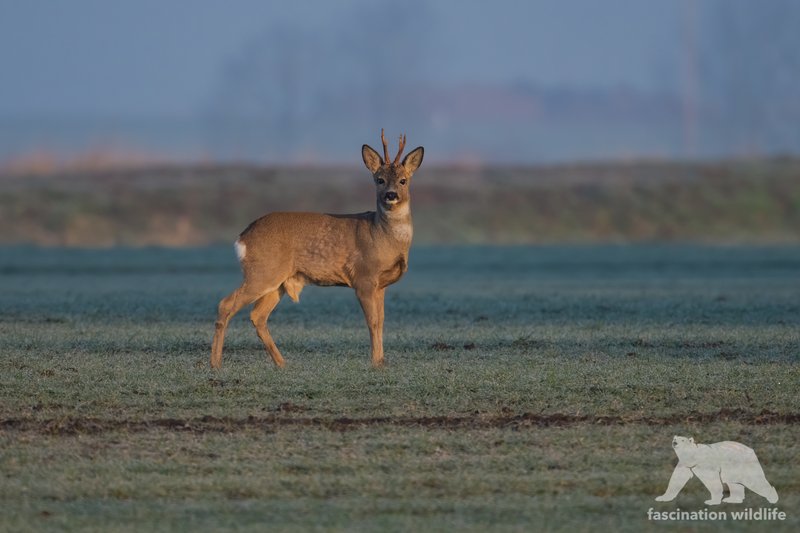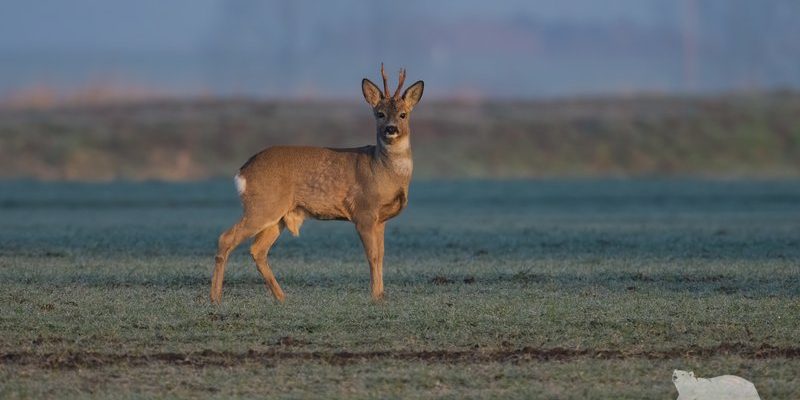
Roe deer, with their delicate stature and graceful movements, are a common sight in many parts of Europe and Asia. Imagine stumbling upon a scene in a quiet forest, where you catch a glimpse of these elegant creatures gracefully bounding through the underbrush. Their sleek fur and gentle demeanor can make anyone stop and marvel at their beauty. But there’s more to these fascinating animals than just their looks.
Roe deer blend seamlessly into their natural surroundings, making them a captivating subject for wildlife enthusiasts and casual observers alike. In this article, we’ll explore their habitat, behavior, diet, and the many unique traits that set Roe deer apart from other deer species. So, whether you’re an avid nature lover or just curious about these charming creatures, let’s dive in!
Physical Characteristics
Roe deer are small to medium-sized deer, typically weighing between 20 to 30 kilograms (44 to 66 pounds). Their bodies are slender and agile, designed perfectly for their forested habitats. They stand about 65 to 95 centimeters (26 to 37 inches) tall at the shoulder. One of the most distinctive features is their reddish-brown fur, which changes color with the seasons—turning more grayish in winter. This adaptation helps them blend in seamlessly with their surroundings.
The males, known as bucks, possess short antlers that they shed annually and regrow in spring. These antlers can grow up to 30 centimeters (12 inches) long and are typically branched, resembling a small “v” shape. The does, or female Roe deer, are slightly smaller and do not have antlers. Instead, they showcase a more nurturing nature, often seen caring for fawns in the lush vegetation of their habitat.
Another striking feature of Roe deer is their large, expressive eyes and alert ears. Their keen senses allow them to spot potential predators from a distance. In fact, they’re known for their excellent hearing and vision, giving them an advantage in staying safe while foraging for food.
Habitat and Distribution
Roe deer thrive in a variety of habitats, favoring woodlands, forest edges, and open fields. They are most commonly found throughout Europe, particularly in the UK, Scandinavia, and parts of eastern Europe. In addition to forests, they also adapt well to agricultural landscapes, making them a frequent visitor in farmlands where they find plenty of food.
They are not overly picky about their home turf, often being spotted in areas that combine dense foliage for shelter and open spaces for foraging. Roe deer are generally solitary creatures, but you might occasionally see them in small groups, especially during winter when they seek more warmth and protection from the elements.
Interestingly, Roe deer have a unique behavior known as “flee and freeze.” When they sense danger, they often remain still, blending into the environment, instead of running away immediately. This tactic can make spotting them quite challenging, as they rely on their camouflage to evade predators.
Diet and Feeding Habits
Roe deer are primarily herbivorous, feeding on a diverse diet that includes grasses, herbs, leaves, and fruits. They are especially fond of young shoots and tender plants, which provide them with essential nutrients. During spring and summer, you’ll find them munching on fresh foliage, while in autumn and winter, they often turn to bark, buds, and fallen fruits.
They are crepuscular, meaning they are most active during dawn and dusk, which are prime times for foraging. This behavior not only helps them avoid the heat of the day but also allows them to evade many of their natural predators, which tend to be more active during the day. When feeding, they use their sharp incisors to nibble on the most succulent parts of plants, showcasing their selective eating habits.
Roe deer also have a fascinating way of digesting food. Unlike some other herbivores, they have a simple stomach that allows for quicker digestion. This means they can process their food more efficiently, which is vital for survival in the wild. They are selective grazers, often returning to favorite feeding spots, ensuring they get the best nutrition available.
Reproduction and Lifespan
Roe deer typically reach sexual maturity at around 6 to 12 months. Their mating season, known as the rut, occurs in late summer to early autumn, when the bucks become more aggressive and vocal. During this time, they engage in displays of dominance and will often clash with other males to gain access to females. The does have a unique reproductive trait; they exhibit a phenomenon called embryonic diapause, allowing them to delay the development of their embryos until conditions are ideal.
A female Roe deer generally gives birth to one fawn, although twins are not unheard of. Fawning usually occurs in late spring to early summer, with the mother seeking out hidden spots in dense vegetation to keep her fawn safe. After birth, the doe will often leave the fawn hidden to protect it from potential threats. She returns regularly to nurse and care for it, showcasing the strong maternal bond between them.
The lifespan of Roe deer in the wild can range from 8 to 12 years, although some individuals have been known to live longer under optimal conditions. In captivity, they may live up to 15 years due to the absence of natural predators and access to consistent food sources. However, despite their resilience, Roe deer face challenges such as habitat loss and hunting, which can impact their numbers in certain areas.
Conservation Status
While Roe deer are not currently endangered, their populations can be affected by various factors, including habitat destruction and hunting. In many European countries, they are protected by law, and conservation efforts are in place to ensure their habitats remain safe from development and degradation. Wildlife reserves and national parks play a crucial role in providing these animals with safe and suitable environments.
A significant threat to Roe deer comes from road traffic, as they often cross roads, which can lead to fatal accidents. Many communities are working on initiatives to create wildlife corridors and crossings to help them navigate their habitats safely. Public awareness campaigns are also essential in educating the public about the importance of preserving these elegant creatures and their ecosystems.
In recent years, there have been successful conservation projects aimed at monitoring Roe deer populations and studying their behavior. By understanding how they interact with their environment, conservationists can implement effective strategies to protect them and maintain healthy populations. This is vital for the well-being of our forests and the biodiversity they support.
Interesting Facts About Roe Deer
Roe deer have some unique traits that make them truly special. For instance, they have a distinctive “alarm call” that signals danger to other deer in the area. This soft bark can be both a warning and a way for them to communicate with each other. Another interesting fact is their ability to jump—they can leap up to 2 meters (6.5 feet) high and cover distances of about 6 meters (20 feet) in a single bound. This skill helps them navigate through their forested home.
Additionally, Roe deer are known for their remarkable eyesight. They can see a wider range of colors than humans, which helps them detect predators lurking in their environment. This adaptation is crucial for their survival, allowing them to blend into their surroundings and evade threats more effectively.
Lastly, did you know that Roe deer can be quite playful? Young fawns often engage in playful behavior, leaping and running around in the early mornings. This not only helps them build strength and coordination but is also an adorable sight for anyone lucky enough to witness it!
FAQ
What is the average size of a Roe Deer?
The average size of a Roe Deer can vary depending on their age and sex. Adult males typically weigh between 20 to 30 kilograms (44 to 66 pounds) and stand about 65 to 95 centimeters (26 to 37 inches) tall at the shoulder. Meanwhile, females are usually slightly smaller.
Where do Roe Deer typically live?
Roe Deer prefer habitats like woodlands, forest edges, and open fields. They are commonly found throughout Europe and parts of Asia, adapting well to various environments, including agricultural areas.
What do Roe Deer eat?
Roe Deer are herbivorous creatures that primarily feed on grasses, herbs, leaves, and fruits. They prefer tender shoots and foliage, especially during spring and summer, while turning to bark and buds in autumn and winter.
How long do Roe Deer live?
In the wild, Roe Deer typically have a lifespan of 8 to 12 years, though some can live longer under ideal conditions. In captivity, they might live up to 15 years due to the absence of natural threats and consistent food availability.
Are Roe Deer social animals?
Roe Deer are generally solitary creatures, although they might be seen in small groups, especially during the winter months. They prefer to keep their distance from one another, which helps reduce competition for food.
How do Roe Deer communicate?
Roe Deer communicate through a variety of vocalizations, including soft barks that serve as alarms to warn others about potential threats. They also use body language to convey their feelings, especially during mating season.
What are the main threats to Roe Deer?
Roe Deer face several threats, including habitat loss due to urban development, hunting, and vehicle collisions. Conservation efforts are critical to protect these animals and their habitats from such dangers.
Can Roe Deer adapt to different environments?
Yes! Roe Deer are quite adaptable and can thrive in various environments, from dense forests to open agricultural land. They adjust their diets and behaviors based on the resources available in their surroundings.
Do Roe Deer have any natural predators?
Yes, Roe Deer have natural predators, including wolves, foxes, and large birds of prey. However, their agility and keen senses help them evade these threats in the wild.
How do Roe Deer care for their young?
After giving birth, the doe keeps her fawn hidden in dense vegetation, returning frequently to nurse it. The fawn stays hidden during the day to protect it from predators until it grows strong enough to accompany its mother.

